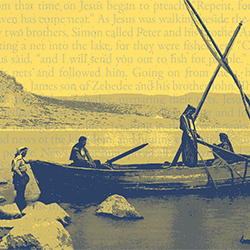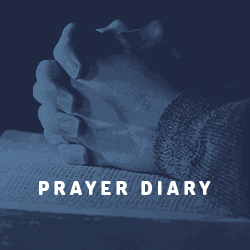31 January 2024

Don’t sip the Bible. Binge it.
Mark Stephens
The shuffle button.
We’re all familiar with the shuffle button.
When you open up Spotify, or whichever music app takes your fancy, there’s nearly always the option to randomise the playlist.
Musicians will hate you for it. So much so that in 2021 Adele successfully petitioned Spotify to get the button removed from albums. But given half a chance, we will hit that button.
You know where you don’t get a shuffle button? Netflix.
Yes I know there is a function that will randomly select a new show for you to watch if you can’t bring yourself to pick. But once you have settled on a series, once you have entered into the episode list, there is no shuffle button.
You don’t open up Stranger Things, Season 4, and start with Episode 7 – and then go back to Episode 3, kick forward to Episode 9, only to go back and finally watch Episode 1.
The reason?
Stories don’t make any sense when you jumble up the pieces like that.
That, by the way, was Adele’s point for Spotify. She famously tweeted: “Our art tells a story and our stories should be listened to as we intended.”
Stories don’t make any sense when you jumble up the pieces
So here’s my question – why do we read the Bible like that?
We flip open to chapter 12 – and dive back to chapter 3 – spice it up with chapter 7.
"Most of us experience the Bible in tiny little bits, and then we shuffle all those bits around. Is it any wonder that sometimes it doesn’t make any sense?"
Most of us experience the Bible in tiny little bits, and then we shuffle all those bits around. Is it any wonder that sometimes it doesn’t make any sense?
The Bible was not written to be read in bits. That is true for nearly most of the Bible. It is doubly true for the Gospels
You might have a favourite story from Jesus – the Parable of the Prodigal Son, or the Labourers in the Vineyard. You might have a favourite story about Jesus, like turning water into wine at Cana.
But if I asked you which Gospel does that ‘bit’ come from – some of us would draw a complete blank.
Yet those very same people, if I was to play them a snippet of Star Wars, or something from the latest season of The Crown, could tell me the exact location within the narrative.
When you love a story – you always know how the bits fit together. But here we are, taking these stories of Jesus, and cavalierly breaking them into tiny bits, only to then jumble all those bits into a jigsaw.
Is that really a problem? Yes, it is.
For many years, one of my favourite YouTube videos has been an alternative trailer for Mary Poppins, called “Scary Mary”. Go on, search it up right now.
What you’ll soon find is a trailer that takes random scenes from Mary Poppins and splices them together to make it look like a horror film. It’s easy if you try. Add a scary soundtrack, and the effect is complete. Because once you break a story into bits, jumble it all around, give it a little mood music – you can make the bits mean anything.
The life and ministry of Jesus is given to us in the form of four stories. We call those stories Gospels – and they are superbly written as interconnected narratives with a beginning, a middle, and an end.
I meet lots of Christians, young and old, who seem super confident that they know exactly what Jesus is like, how Jesus would think, they know what he would say, they know what he would do.
Yet they’ve never read a Gospel from beginning to end. Not once. That’s wild.
They know three quotes, two parables, and one miracle story – but apparently they’ve got it all figured out.
"This is something like knowing the trailer, and thinking you’ve watched the movie."
This is something like knowing the trailer, and thinking you’ve watched the movie.
The guaranteed place where we will fully encounter Jesus is by reading the Gospels whole.
What do you get to see when you read the Gospels as whole stories?
In a phrase - so much more. What was a disconnected series of events and teachings resolves into the most compelling pictures of an amazing Messiah.
Let me give you just two examples – one using the Gospel of Mark the other from the Gospel of Luke
The Gospel of Mark is the second of our Gospels, but it also happens to be the quickest to read. It will take the average reader 45 minutes to read through the Gospel of Mark in one sitting. That is half the time of the average movie, and roughly the size of your average podcast. In other words, 45 minutes just isn’t that long.
So why have you never read through Mark in one sitting? Because everything and everyone keeps telling you to stop. You go to church, the Bible reading is short, and then they stop. You go to a Bible study group, they read a bit, and then they stop.
If that’s not enough, the very way our Bible texts are laid out discourages connected reading. Bibles are usually in two-column format. Now we don’t read books in two-column format. Dictionaries are laid out in two-column format. Nobody reads the dictionary. And if you do – well…all the best for the spelling competition.
And if it’s not the two-column format – there are so many numbers – chapters, verses – and then the headings. No other story you read has this many numbers, no other story has all these headings disrupting the text. All those numbers cue us to believe we should never read this text quickly, nor should we ever read it whole. The subtext is that we must stop and reflect over every single sentence.
The truth is that the chapters and verses are not original. They were added, as a help, over a thousand years after the Gospels and they’re not a reading guide, they’re a finding guide. The numbers are there so everybody knows that we are all looking at the same part of the Bible.
Think, for a moment, of a DVD. The DVD is rarely spotted in the wild these days. It is fast going the way of the Tasmanian Tiger. But if you can remember back far enough, you will know that DVD’s have chapters too. We call it “scene selection” – chapter 21, chapter 27.
Nobody goes to scene selection when they first watch a film. You want to experience the whole thing first, and then you might say “let’s watch that bit again – what was going on there.”
Only with the Bible do we watch scene selection first.
The Gospel’s were written to be experienced as connected stories. Then you can go back and see the bits that need to be focused on.
When you read Mark as a connected story here is what you see.
In the first 8 chapters of Mark everybody is asking questions about Jesus. Over and over again Jesus keeps on doing and saying things that are amazing, confronting, sometimes even offensive.
What is this?
Why does this man talk like that?
Why does he eat with sinners?
Who is this?
Mark keeps up this repetition to tell you - Jesus was provocative. He lived a life that made people ask questions. By the way, you only know it is repetition if you read the whole Gospel.
Mark has picked a collection of these incidents and deliberately put them together because he wants you to see that the person of Jesus requires an explanation.
Then, right in the middle of Mark, Jesus becomes the questioner. He turns to Peter and asks him: “Who do you say that I am?”
It seems deliberately set up by Mark to have this as the central question of his Gospel – that the reader, like the characters in the narrative, have to give an answer on the identity of Jesus.
If you really want to know someone, you give them more than five minutes. The life of Jesus is so wildly brilliant that it cannot be contained in just one account.
You can only feel the force of that question if you read the whole of Mark’s Gospel. If you start halfway through Jesus’s question doesn’t make much sense.
Here is a somewhat rough, but serviceable, metaphor.
Don’t sip the Bible. Binge it.
You binge on Netflix because you want the whole story. It is an indication of how much it matters to us to experience everything from the beginning to the end. Don’t sip the Gospels. At least not at first. Binge them.
Knowing the whole story will enable you to see the beauty and power of having four Gospels. Although it is the same Jesus, these four separate portraits each provide a different angle on his power, his love, and his saving work.
For example, what if you are convinced that Jesus could never love a person like you? I had a friend who would come to church sporadically. She was a single mum, she’d had two kids by two different dads, and she had somehow got it into her head that Jesus wanted perfect people. If that were true - she would never fit in. You know what she needed?
She needed the Gospel of Luke.
Luke is the gospel for outsiders. Luke’s story is so intentionally about the radical welcome of Jesus. He has gathered together all these stories of people who were on the margins, the uneducated, the unclean, the unnoticed. And over and over again, Luke shows that the love of Jesus included the excluded.
There is a reason that the parable of the prodigal son only appears in Luke – because it is a story of someone so ashamed at their sin they wonder if they could ever come back to God. And Jesus says – I have good news – God is running towards you, not away. This is Luke’s thing. No matter what you’ve done, no matter what you’ve become, God wants you home.
But you only feel the full strength of that emphasis when you experience the whole story. When you read the whole of Luke, you see that this gracious love of Jesus is not an occasional gesture, it is his default posture.
Don’t leave your Bible in pieces. You hate it when people take your words out of context. You get ticked when another person thinks they know everything about you because you’ve spoken for five minutes.
So why do we that with Jesus?
You know three quotes, two parables, and one miracle story. You know the trailer. But the movie’s so much better.
So if you want more of Jesus – here’s where you start. Read the whole Gospel.
If you love someone’s words, you want the whole story.
If you really want to know someone, you give them more than five minutes. The life of Jesus is so wildly brilliant that it cannot be contained in just one account.
God gave us four portraits of one extraordinary life so that just like a diamond, you get to see every facet every glorious angle – on our Saviour, our Teacher, our Healer, our Lord.
Take and Read.
Mark Stephens
SMBC Lecturer in New Testament







